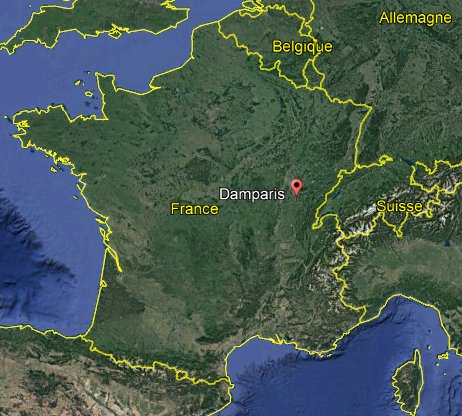
The index page for the 1954 French flap section of this website is here.
Reference for this case: 9-Jan-54-Damparis.
Please cite this reference in any correspondence with me regarding this case.
In his 1956 book "Alerte Dans Le Ciel", the journalist and pioneer ufologist Charles Garreau interpreted what was a meteor pass over eastern France on January 9, 1954, as being an overflight by a flying saucer.
Among the cases he cited, there was a testimony of Mr. Bernard Mercier, engineer at the Société Générale de Fonderie who wrote to him from Damparis:
"... The craft was clearly discoid, seeming to turn on itself, and progressing at a speed which I evaluated at twice that of a jet plane. It seems to me at an angular height of 30 at 40° above the horizon. It had an apparent diameter slightly smaller than that of the moon. I deduced from it that its diameter could be about fifty meters, and its height of about 2000 meters... It disappeared in the direction of Lons-le-Saunier after flying over the Tavaux aviation camp. Its flight was absolutely silent, and, against the still dark sky, it projected a blinding light that turned yellow, similar to that produced by burning copper in oxygen..."
[Ref. cgu2:] CHARLES GARREAU:
The journalist, author and pioneer ufologist indicated that on Saturday January 9, 1954, at dawn, there was a "flash invasion" on the east of France; which according to him "seems to be a highlight in the voluminous 'flying saucers' file."
Garreau indicated that from "all places" in the region, information flocked to his desk, about an object that "flew for almost two hours above the East."
He said that the first reports left the door open to all hypotheses, meteor, balloon, jet plane, "or saucer!", but that the reports which reached him later would eliminate all these hypotheses except that of the flying saucer.
He recalled that meteors always have a perfectly rectilinear trajectory, a relatively high constant speed of 30.000 to 40.000 km/h, and that balloons have an apparent speed which cannot exceed that of the strongest stratospheric currents, from 300 to 400 km/h.
He indicated that Mr. Bernard Mercier, engineer at the Société Générale de Fonderie wrote to him from Damparis:
"... The craft was clearly discoid, seeming to turn on itself, and progressing at a speed which I evaluated at twice that of a jet plane. It seems to me at an angular height of 30 at 40° above the horizon. It had an apparent diameter slightly smaller than that of the moon. I deduced from it that its diameter could be about fifty meters, and its height of about 2000 meters... It disappeared in the direction of Lons-le-Saunier after flying over the Tavaux aviation camp. Its flight was absolutely silent, and, against the still dark sky, it projected a blinding light that turned yellow, similar to that produced by burning copper in oxygen..."
He explained that no meteor or balloon could have engaged in the "zigzag" shown according to him by the observations of this morning, and that no plane of the time could have been able "to stop then accelerate at more than 3,000 per hour", performances which he deduced from some of the observations and distances between observation spots relative to the reported observations hours.
Garreau added that "to leave no doubt", he had questioned the various regional weather stations, and that he had been told that no balloon had been launched.
At the American base in Semoutiers, near Chaumont, he was told "It was neither a balloon, nor a plane, from here."
He added that the Besançon observatory had seen nothing, and that the Contrexéville and Dijon radar sets as well as the Perrogney goniometer in Haute-Saône had seen nothing, since their specialists only took their duty at 8 a.m.
He added that the "Scientific bureau" had hesitated to take a position, saying that the only possible "natural" explanation would be that of a meteor, but "the journey described by the object is such that it could not have been a single meteor. It would therefore have to be admitted that it was a swarm of meteorites which crossed "(under the clouds !!!)" the sky of eastern France following different trajectories."

|
The meteor of January 9, 1954, at 07:48 a.m.
(These keywords are only to help queries and are not implying anything.)
Damparis, Jura, Bernard Mercier, engineer, craft, disc, rotation, fast, Lons-le-Saunier, silent, dazzling, luminous, yellow, combustion, copper
[----] indicates sources that are not yet available to me.
| Version: | Created/Changed by: | Date: | Change Description: |
|---|---|---|---|
| 1.0 | Patrick Gross | February 5, 2020 | First published, [cgu2]. |